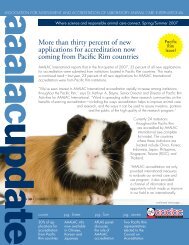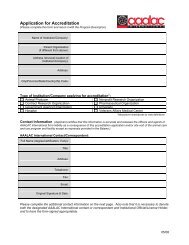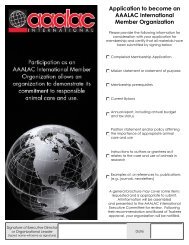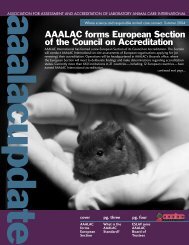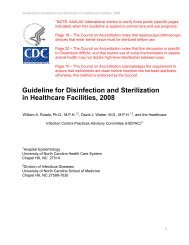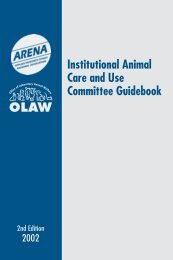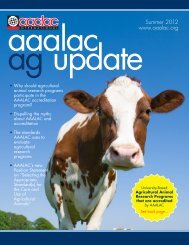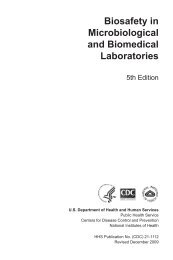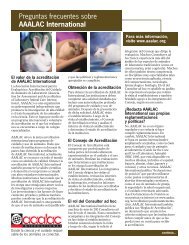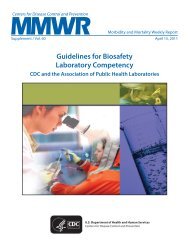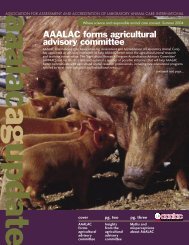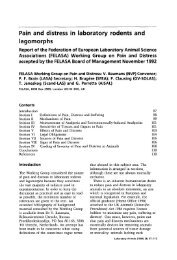Guide for the Care and Use of Agricultural Animals in Research and ...
Guide for the Care and Use of Agricultural Animals in Research and ...
Guide for the Care and Use of Agricultural Animals in Research and ...
You also want an ePaper? Increase the reach of your titles
YUMPU automatically turns print PDFs into web optimized ePapers that Google loves.
Chapter 1: Institutional PoliciesScientific <strong>and</strong> pr<strong>of</strong>essional judgment <strong>and</strong> concern<strong>for</strong> <strong>the</strong> humane treatment <strong>of</strong> animals are required<strong>for</strong> <strong>the</strong> proper care <strong>of</strong> animals used <strong>in</strong> agriculturalresearch <strong>and</strong> teach<strong>in</strong>g (referred to <strong>in</strong> this guide as agriculturalanimal care <strong>and</strong> use). Because a variety <strong>of</strong>management systems <strong>and</strong> physical accommodationsmay be used <strong>for</strong> agricultural animals, an underst<strong>and</strong><strong>in</strong>g<strong>of</strong> <strong>the</strong> husb<strong>and</strong>ry needs <strong>of</strong> each species <strong>and</strong> <strong>of</strong> <strong>the</strong> particularrequirements <strong>of</strong> agricultural research <strong>and</strong> teach<strong>in</strong>gis essential <strong>for</strong> an effective <strong>in</strong>stitutional program <strong>of</strong>agricultural animal care <strong>and</strong> use (Strickl<strong>in</strong> <strong>and</strong> Mench,1994; Granstrom, 2003). Critical components <strong>of</strong> sucha program should <strong>in</strong>clude 1) clearly established l<strong>in</strong>es<strong>of</strong> authority <strong>and</strong> responsibility; 2) an active InstitutionalAnimal <strong>Care</strong> <strong>and</strong> <strong>Use</strong> Committee (IACUC); 3)procedures <strong>for</strong> self monitor<strong>in</strong>g <strong>of</strong> <strong>the</strong> IACUC throughsemi-annual review <strong>of</strong> programs <strong>and</strong> facility oversightby <strong>the</strong> <strong>in</strong>stitutional <strong>of</strong>ficer; 4) appropriately ma<strong>in</strong>ta<strong>in</strong>edfacilities <strong>for</strong> proper management, hous<strong>in</strong>g, <strong>and</strong> support<strong>of</strong> animals; 5) an adequate program <strong>of</strong> veter<strong>in</strong>arycare; <strong>and</strong> 6) tra<strong>in</strong><strong>in</strong>g <strong>and</strong> occupational health programs<strong>for</strong> <strong>in</strong>dividuals who work with <strong>the</strong> animals (ARENA/OLAW, 2002). This chapter is <strong>in</strong>tended to aid <strong>in</strong> <strong>the</strong>development <strong>of</strong> <strong>in</strong>stitutional policies <strong>and</strong> programs <strong>for</strong>agricultural animal care <strong>and</strong> use.MONITORING THE CARE AND USEOF AGRICULTURAL ANIMALSEach <strong>in</strong>stitution should establish an agricultural animalcare <strong>and</strong> use program with clearly designated l<strong>in</strong>es<strong>of</strong> authority <strong>in</strong> accordance with this guide <strong>and</strong> <strong>in</strong> compliancewith applicable federal, state, <strong>and</strong> local laws,regulations, <strong>and</strong> policies.The chief executive <strong>of</strong>ficer or responsible adm<strong>in</strong>istrative<strong>of</strong>ficial <strong>of</strong> <strong>the</strong> <strong>in</strong>stitution should appo<strong>in</strong>t a committee,<strong>the</strong> IACUC, to monitor <strong>the</strong> care <strong>and</strong> use <strong>of</strong>agricultural animals <strong>in</strong> agricultural research <strong>and</strong> teach<strong>in</strong>gactivities. The IACUC should be composed <strong>of</strong> <strong>in</strong>dividualswho are qualified by experience or tra<strong>in</strong><strong>in</strong>g toevaluate <strong>the</strong> programs <strong>and</strong> proposals under review <strong>and</strong>should <strong>in</strong>clude at least one <strong>in</strong>dividual from each <strong>of</strong> <strong>the</strong>follow<strong>in</strong>g categories (no <strong>in</strong>dividual category should beover-represented):1• A scientist who has experience <strong>in</strong> agriculturalresearch or teach<strong>in</strong>g <strong>in</strong>volv<strong>in</strong>g agriculturalanimals;• An animal, dairy, or poultry scientist who hastra<strong>in</strong><strong>in</strong>g <strong>and</strong> experience <strong>in</strong> <strong>the</strong> management <strong>of</strong>agricultural animals;• A veter<strong>in</strong>arian who has tra<strong>in</strong><strong>in</strong>g <strong>and</strong>experience <strong>in</strong> agricultural animal medic<strong>in</strong>e <strong>and</strong>who is licensed or eligible to be licensed topractice veter<strong>in</strong>ary medic<strong>in</strong>e;• A person whose primary concerns are <strong>in</strong> anarea outside <strong>of</strong> science (e.g., a faculty memberfrom a nonscience department, a staff member,a student, a member <strong>of</strong> <strong>the</strong> clergy, or an<strong>in</strong>stitutional adm<strong>in</strong>istrator);• A person who is not affiliated with <strong>the</strong><strong>in</strong>stitution <strong>and</strong> who is not a family member<strong>of</strong> an <strong>in</strong>dividual affiliated with <strong>the</strong> <strong>in</strong>stitution.This public member is <strong>in</strong>tended to providerepresentation <strong>for</strong> general community <strong>in</strong>terests<strong>in</strong> <strong>the</strong> proper care <strong>and</strong> treatment <strong>of</strong> animals<strong>and</strong> should not be a person who uses animals<strong>in</strong> agricultural or biomedical research orteach<strong>in</strong>g activities at <strong>the</strong> college or universitylevel; <strong>and</strong>• O<strong>the</strong>r members as required by <strong>in</strong>stitutionalneeds <strong>and</strong> applicable laws, regulations, <strong>and</strong>policies.Because <strong>of</strong> experience <strong>and</strong> tra<strong>in</strong><strong>in</strong>g, however, one<strong>in</strong>dividual may adequately fulfill more than a s<strong>in</strong>glerole on <strong>the</strong> IACUC, but <strong>the</strong> committee should not havefewer than 5 members. It is strongly recommended thatthis committee be one that also monitors <strong>the</strong> care <strong>and</strong>use <strong>of</strong> laboratory animals at <strong>the</strong> <strong>in</strong>stitution, provid<strong>in</strong>gthat <strong>the</strong> special membership requirements outl<strong>in</strong>edabove are met. This recommendation can be fulfilled byseveral different types <strong>of</strong> committee structures, <strong>in</strong>clud<strong>in</strong>ga s<strong>in</strong>gle <strong>in</strong>stitutional committee, unit committees(e.g., departmental, college, or program) that reviewagricultural as well as biomedical uses <strong>of</strong> animals. Theoverrid<strong>in</strong>g goal should be to facilitate centralized, uni<strong>for</strong>m,<strong>and</strong> high-quality oversight <strong>of</strong> <strong>the</strong> <strong>in</strong>stitution’s animalcare program.



